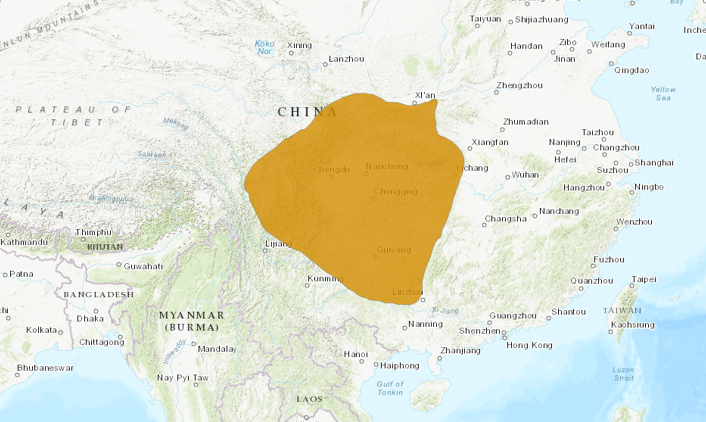Birdfinding.info ⇒ Shy and elusive, and therefore rarely seen, but locally common—especially in the arc of rugged hills that stretches from central Sichuan north and east through southern Shaanxi. Most readily observed at established hides where some are drawn to food or water and become habituated. Sites where it can often be found include: in Sichuan, Wolong and Tangjiahe Nature Reserves; in Shaanxi, Foping Nature Reserve, Gumuping, and Baishizhen (all in Yangxian County); and in Henan at Guo Bei Shi. In England, it seems to be found most consistently in Norfolk around Dersingham Bog.
Golden Pheasant
Chrysolophus pictus
Endemic to central China, where it inhabits foothill and mountain forests and semiopen habitats from around 800 to 1,600 m elevation.
Occurs in hill country and mountains from southeastern Qinghai and southern Gansu east across southern Shaanxi to southwestern Henan, and south through Sichuan, Chongquing, Guizhou, Hubei, and western Hunan to northern Guangxi.
Introduced populations appear to be well-established locally in England and New Zealand (North and South Islands).
Attempted introductions elsewhere have generally failed, but there may be a small population on Maui (Waikamoi Preserve).
Identification
Male is among the splashiest of birds: a small pheasant with scarlet underparts, lush golden crest and rump, blue-green back, deep-blue wing coverts, and long coppery tail feathers vermiculated with black.
Behind its golden crest, another set of elongated feathers forms a cape or “head-dress” of orange with black scaling. In display, the male erects or fans these feathers.
The legs are long and yellow-to-orange. The bill is the same color.
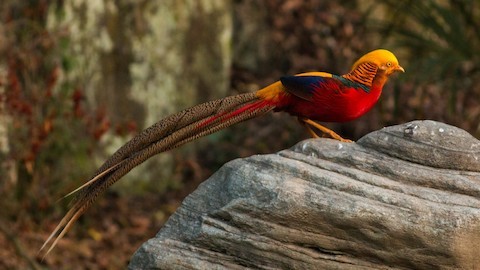
Golden Pheasant, male. (Shaanxi, China; January 19, 2020.) © Ruocheng Hu
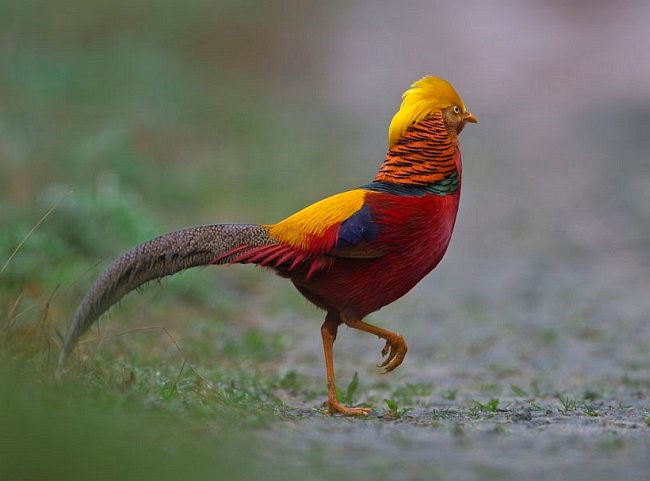
Golden Pheasant, male. (Northern Sichuan, China; April 10, 2009.) © Dong Lei
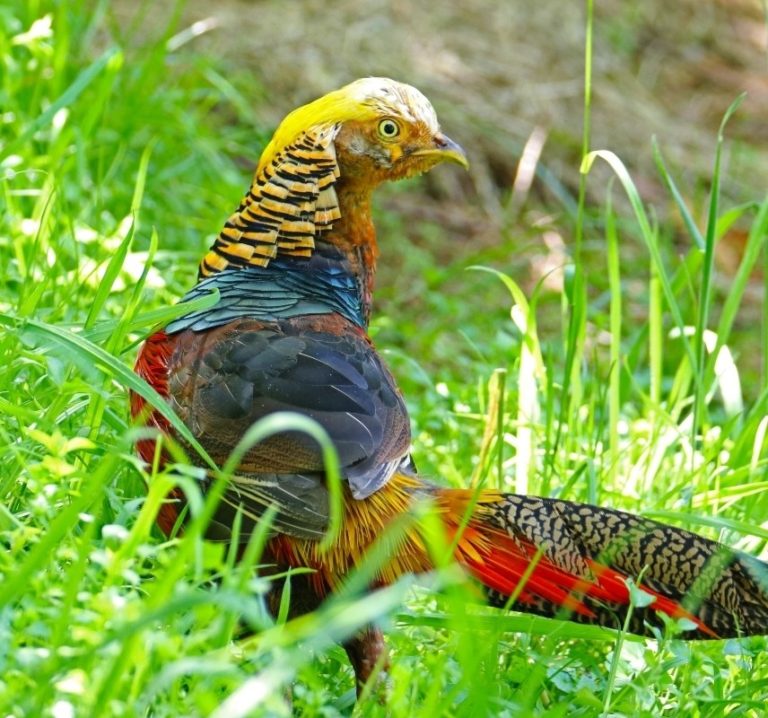
Golden Pheasant, male. (Southland, South Island, New Zealand; February 4, 2019.) © QuestaGame
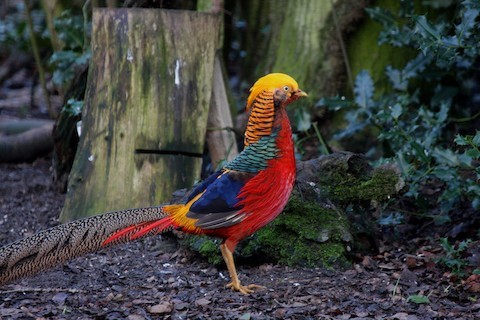
Golden Pheasant, male. (Sculthorpe Moor Nature Reserve, Norfolk, England; January 20, 2011.) © Peter Turner
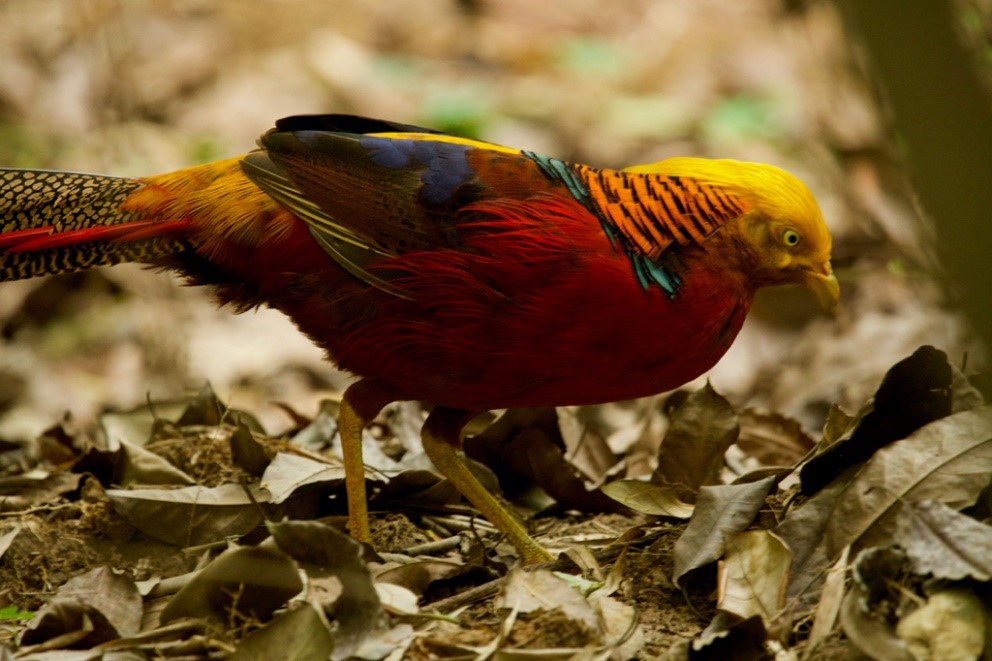
Golden Pheasant, male. (Chengdu, Sichuan, China; May 13, 2018.) © Qin Huang
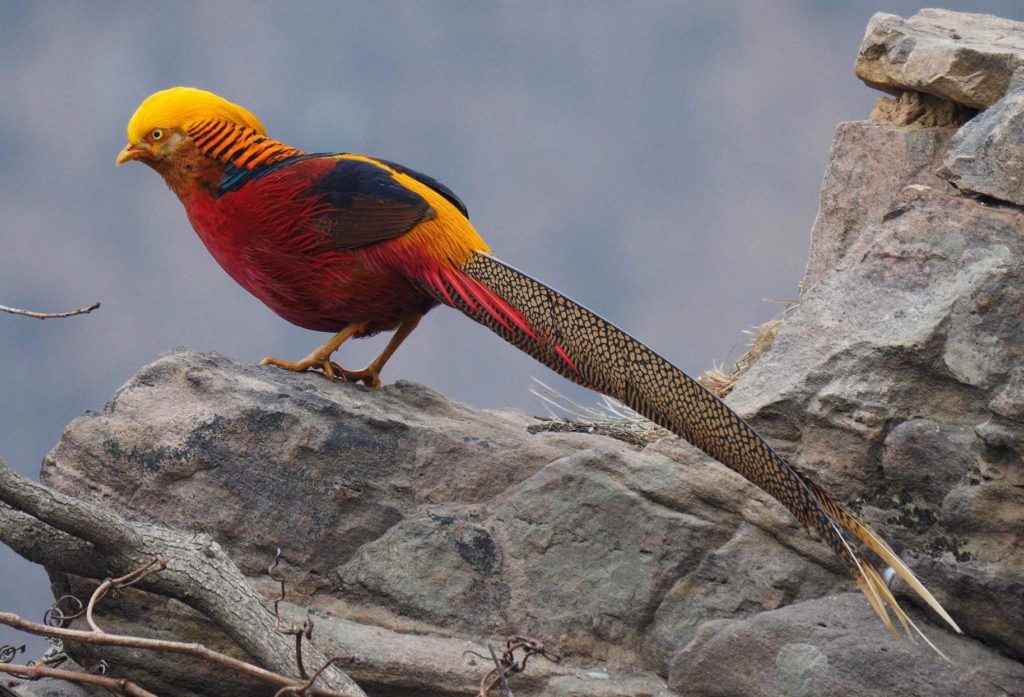
Golden Pheasant, male. (Quan Shui Wan, Henan, China; January 1, 2019.) © Josep del Hoyo
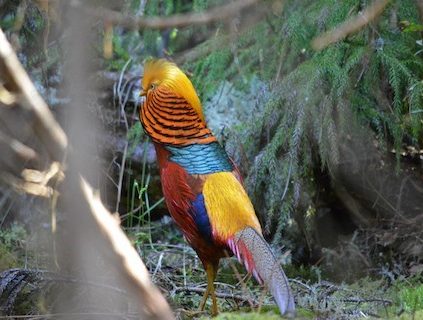
Golden Pheasant, male with neck-ruff partly fanned. (Waikamoi Preserve, Maui, Hawaii; March 20, 2014.) © Alex Wang

Golden Pheasant, male. (Tangjiahe Nature Reserve, Sichuan, China; March 13, 2015.) © Summer Wong
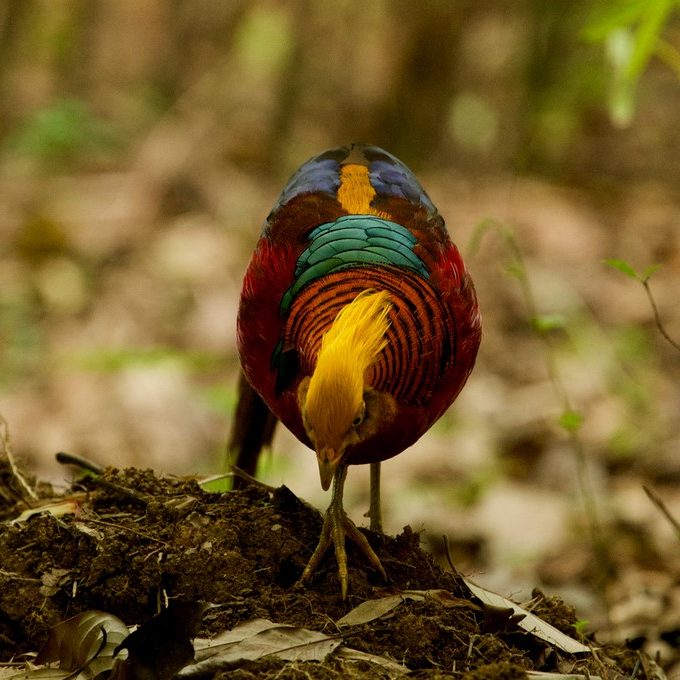
Golden Pheasant, male showing long golden crest and vivid patchwork of colors on the upperparts. (Chengdu, Sichuan, China; May 13, 2018.) © Qin Huang

Golden Pheasant, male showing luxuriant golden feathers on rump and red in tail. (Henan, China; February 4, 2017.) © Khalid Sharif
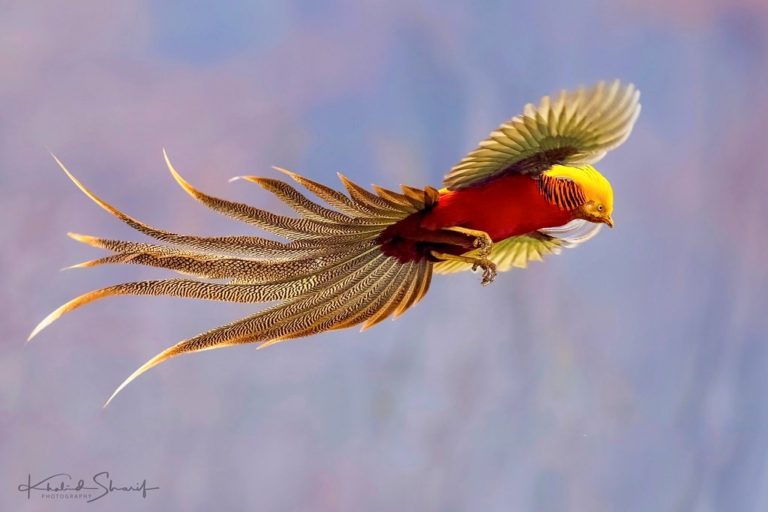
Golden Pheasant, male in flight. (Henan, China; February 2, 2017.) © Khalid Sharif
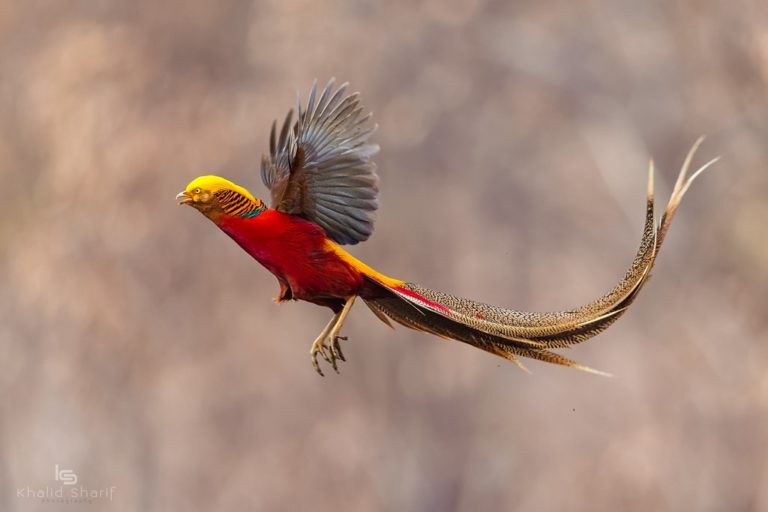
Golden Pheasant, male in flight. (Henan, China; February 4, 2017.) © Khalid Sharif
Female is pale to medium-brown, and extensively marked with blackish bars above and below; most heavily marked on the wings.
The female’s tail is much shorter than the male’s, finely vermiculated blackish-and-pale-brown, and bars that contrast sharply on one side and weakly on the other.
Like the male, the female’s legs and bill are yellowish, but usually duller.
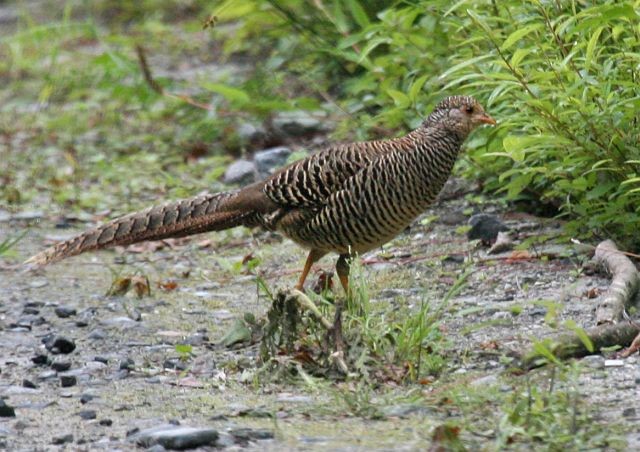
Golden Pheasant, female showing heavily barred underparts. (Tang Jia He Nature Reserve, Sichuan, China; June 7, 2013.) © Ulrich Weber
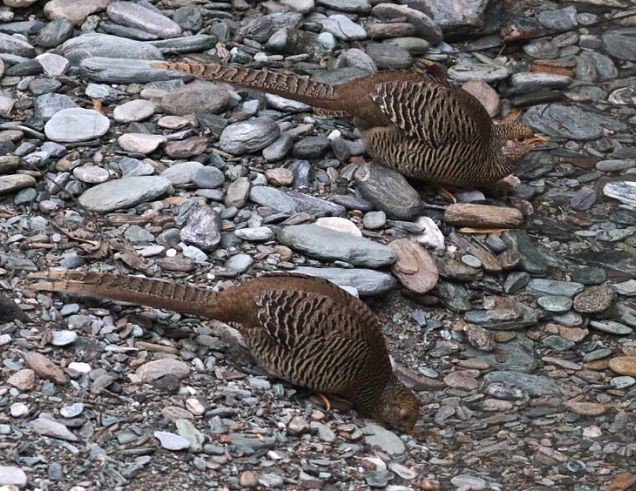
Golden Pheasant, females drinking from a stream. (Tangjiahe, Sichuan, China; March 12, 2016.) © Summer Wong
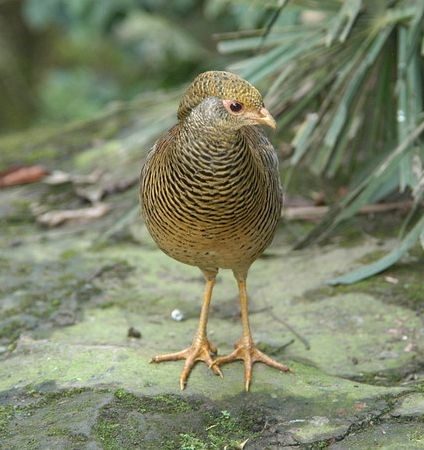
Golden Pheasant, captive female showing yellower-than-average tones on the face and breast. (Bi Feng Xia Wildlife Park, Yaan City, Sichuan, China; November 22, 2006.) © David Blank
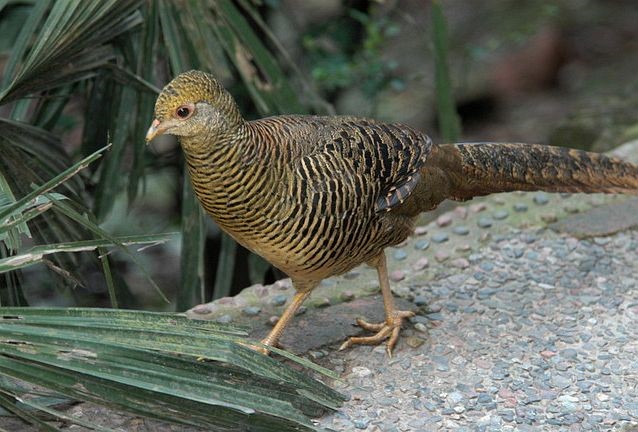
Golden Pheasant, captive female showing yellower-than-average tones on the face and breast. (Bi Feng Xia Wildlife Park, Yaan City, Sichuan, China; November 22, 2006.) © David Blank

Golden Pheasant, captive female—note tail pattern. (Bi Feng Xia Wildlife Park, Yaan City, Sichuan, China; November 22, 2006.) © David Blank
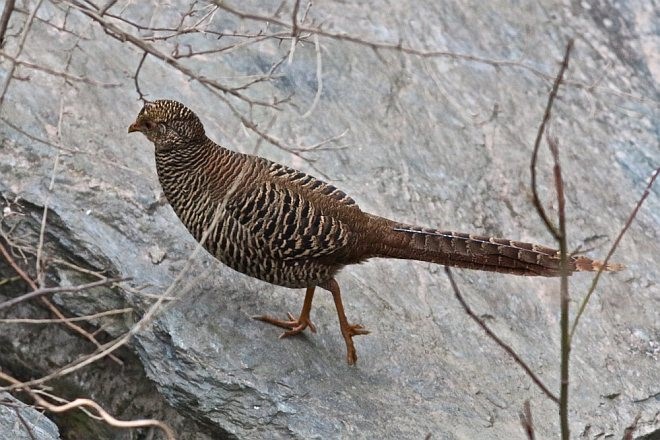
Golden Pheasant, female showing bold barring on wings. (Tangjiahe, Sichuan, China; March 12, 2016.) © Summer Wong
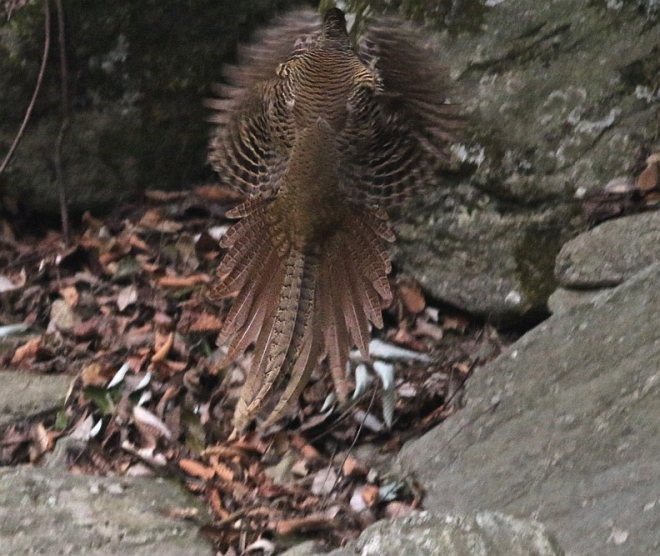
Golden Pheasant, female flushing and showing different patterns of barring on the wings, back, and tail. (Tangjiahe, Sichuan, China; March 12, 2016.) © Summer Wong
Immature males generally resemble females but have the adult male’s tail pattern and traces of its colorful plumage.

Golden Pheasant, immature male showing patches of reddish-orange and typical male tail pattern. (Waikamoi Preserve, Maui, Hawaii; March 4, 2013.) © Michael Walther

Golden Pheasant, immature male showing patches of red and orange and typical male tail pattern. (Qinling Mountains, Shaanxi, China; June 12, 2013.) © Tang Jun
Cf. Female Lady Amherst’s Pheasant. Golden and Lady Amherst’s Pheasants occur near one another in China, but are not known to overlap as Lady Amherst’s occupies higher elevations. Still, both species have been widely introduced and either could therefore occur nearly anywhere in the world.
The females are similar overall but differ somewhat in the tones and pattern of their plumages. Lady Amherst’s is a warmer shade of brown with black bars that are bolder, shorter, and more widely spaced; and has a large patch of mostly bare grayish skin on the face. Leg color also differs: yellowish on Golden versus lead-gray on Lady Amherst’s.
Notes
Monotypic species.
References
BirdLife International. 2018. Chrysolophus pictus. The IUCN Red List of Threatened Species 2018: e.T22679355A131874282. https://dx.doi.org/10.2305/IUCN.UK.2018-2.RLTS.T22679355A131874282.en. (Accessed March 26, 2020.)
eBird. 2020. eBird: An online database of bird distribution and abundance. Cornell Lab of Ornithology, Ithaca, N.Y. http://www.ebird.org. (Accessed March 26, 2020.)
Madge, S., and P.J.K. McGowan. 2002. Pheasants, Partridges, and Grouse: A Guide to the Pheasants, Partridges, Quails, Grouse, Guineafowl, Buttonquails, and Sandgrouse of the World. Princeton University Press, Princeton, N.J.
McGowan, P.J.K., and G.M. Kirwan. 2020. Golden Pheasant (Chrysolophus pictus). In: del Hoyo, J., Elliott, A., Sargatal, J., Christie, D.A. & de Juana, E. (eds.). Handbook of the Birds of the World Alive. Lynx Edicions, Barcelona. https://www.hbw.com/node/53510. (Accessed March 26, 2020.)
Mullarney, K., L. Svensson, D. Zetterström, and P.J. Grant. 1999. Birds of Europe. Princeton University Press, Princeton, N.J.
Xeno-Canto. 2020. Golden Pheasant – Chrysolophus pictus. https://www.xeno-canto.org/species/Chrysolophus-pictus. (Accessed March 26, 2020.)

